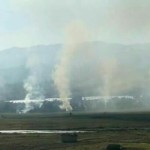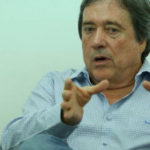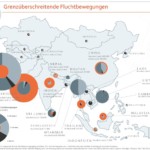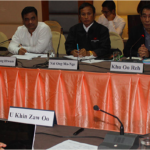Kachinland News (KLN) | October 20, 2016.
“Do not put your trust in man. Rather, trust the constitution that we will be drafting.” These were the very words that Bogyoke Aung San used to address the deep mistrust expressed by Shan, Kachin and Chin representatives about certain ethnic Bamar leaders when he persuaded them to sign the historic Panglong Agreement in February 1947.
With such agreement, it was hoped that the independence generation of national leaders would resolve the deep political and ethnic challenges facing the new union without armed struggles breaking out. But, looking back at the continuing state of conflict in our country, it needs to be asked whether there was really a sincere opportunity for political solutions by peaceful means at that time? And if so, what does it warn of now when military operations are expanding again under a new incarnation of central government when peace hopes have recently been so high?
To understand our sense of concern, the Kachin experience is sadly poignant. Kachin leaders have always been in the forefront of initiatives to give peace and reconciliation a chance in our country. It was Kachin representatives who encouraged other nationality leaders at Panglong to reject a British offer of Home Rule and rally behind the national independence movement led by Aung San. The Panglong Agreement, however, was never honoured and, in the rush to independence, armed struggle rapidly spread across the country.
Since this time, the Kachin people have never wavered in their search for peace. At every change of government in the post-independence era, Kachin organisations – armed and unarmed together with faith-based and community groups – have never failed to support peace negotiations in the hope that they will lead to political solutions. Such desire has continued through every political era, whether military, quasi-civilian or elected government.
Hopes were especially high in 1994 when a bilateral ceasefire agreement was reached with the military government of the State Law and Order Restoration Council. Many Kachins for the first time felt that there was political light at the end of the tunnel, and the Kachin Independence Organisation subsequently participated in the National Convention to draw up the country’s new constitution.
Expectations, however, of national peace and inclusion were ultimately dashed. So it is important to stress that the failure of the 17 years of ceasefire was not for a want of local efforts.* Within the confines of military rule, Kachin organisations sought every avenue to address the dire needs of the conflict-affected after decades of civil war. Community-based activities multiplied and the KIO, along with other peace groups, promoted regional development while advocating constitutional reform and a new general election to institute peace and a representative system of government in the country.
In pursuit of these aims, the KIO – together with 12 other peace groups – submitted a joint vision to the National Convention for a federal system of government to guarantee the equality and autonomy promised by Aung San and the Union’s founders at Panglong in 1947. Their proposals, however, were ignored, with only a promise that they would be put on file. Meanwhile new forms of exploitation and corruption emerged, including environmental destruction, land-grabbing and other human rights abuses. Equally concerning, the efforts by Kachin people to form representative parties to stand in the 2010 general election were blocked. In consequence, few citizens saw improvement in the security or quality of their lives, causing many Kachins to ask: “War or Peace: what’s the difference?”
The 17-year ceasefire was broken immediately after President U Thein Sein took the helm of a quasi-civilian government under the aegis of the 2008 constitution. The unprecedented use of sophisticated weaponry, including fighter jets, helicopter gunships and heavy artillery, has since caused over 100,000 Kachins to flee from government troops. Most continue to languish in internally-displaced persons camps until this very day. At the same time, despite President Thein Sein’s suspension of the Myitsone Dam, the exploitation of natural resources such as jade and timber has only increased. Such ill-treatment and oppression have only furthered a new generation of grievances, and many Kachins are now firmly entrenched in the opinion that they should not abandon armed struggle unless there is a real political solution in sight.
Kachin leaders have nevertheless continued to engage in peace negotiations at every opportunity. From the time of renewed hostilities in 2011, they entered into new peace talks with the government of President Thein Sein, and a breakthrough of sorts appeared to be reached during meetings in October 2013. A new agreement offered the KIO opportunity to get together with other ethnic armed organisations to collectively negotiate with the central government for a political settlement.
Divisive trends, however, in national politics quickly began to emerge; first, the political reform process was separated between parliament and ethnic peace talks; and second, a division developed between the eight ethnic armed organisations that signed a “Nationwide Ceasefire Agreement” with the Thein Sein government last October and a majority of nationality forces, including the KIO, that want to wait until the national peace process is truly inclusive.
Despite these differences, hopes really grew that a new era of peace and reconciliation could be at hand when Daw Aung San Suu Kyi and the National League for Democracy came into government office last March. Optimism developed in spite of the fact that the form of national government remains a centralised, unitary system and the 2008 constitution is still in place. The reality is that, since 1962, there has been only one party in power, the national armed forces or Tatmadaw, and its presence in government is pervasive and indomitable. Nevertheless hopes of peaceful change further increased at the recent “21st Century Panglong Conference” which the KIO also attended. For a brief moment, it appeared that the parliamentary and ethnic peace processes would finally be brought together on the same track in the interest of all peoples.
The potential for peace, however, presently appears short-lived. Tatmadaw operations have once again increased around the holding of peace talks, with offensives escalating from mid-September – including air strikes and artillery shelling – during attacks on KIO positions. On 14 October, the United Nations Under-Secretary-General for Humanitarian Affairs and Emergency Relief Coordinator, Stephen O’Brien, expressed concern that humanitarian aid was being blocked by the authorities in some areas. “I spoke with people who fled violence more than five years ago and who are simply waiting for the guns to go silent before they can go home,” said Mr O’Brien.
This only serves to highlight the long-standing conundrum for the Kachin people: they know only too well that, if the government and Tatmadaw truly wanted, a halt to military offensives would have been achieved a long time ago. This was amply demonstrated during the 17 years of ceasefire and previous times of peace talks. But for over five years now, every peace announcement or initiative has seen no let-up in Tatmadaw operations and build-up. It is almost as if peace talks and ceasefires are being used as a stratagem of war.
Worries, too, are now being felt over the apparent silence and ambivalent position towards the Tatmadaw’s operations by the new NLD government. Fears over the NLD’s lack of understanding or ability to confront these issues increased this week at the first anniversary of the Nationwide Ceasefire Agreement signing at Nay Pyi Taw when State Counsellor Daw Aung San Suu Kyi seemed to suggest that, as long as the NCA is signed, the ethnic conflicts will be over. But if this is the government’s belief, it disregards the fact that neither is the NCA open to all groups nor does the Tatmadaw appear to be bound by it. Recent Tatmadaw operations in the Karen state, an area supposedly covered by the NCA, as well as attacks on the Restoration Council of Shan State, an NCA signatory, further underline this point.
Of course, political transition in Myanmar was always likely to be a formidable task after decades of conflict and military government. It is also recognised that all countries in the world face difficult challenges in achieving democratic political systems that represent the people. Such institutions as the European Union, for example, have problems with centralism and disparity between member states. But while the context might be different, the challenge of such inequalities reflects the experiences in our country where the Tatmadaw has become an inherently authoritarian political and economic structure and successive governments, whether military or elected, support this by positioning themselves close to the status quo.
For the Kachins, who are co-founders of the Union, it is a challenge to overcome this unrepresentative system on their own. But no matter how their actions are viewed by others, the Kachins will continue to defend their rights and repel military aggression wherever it occurs. As experience since independence has long shown, it is a matter of survival. And such sufferings, which afflict many nationalities in our country, cause real harm to inter-community relations. As a new government, once again led by ethnic Bamars, now seeks to resolve the country’s challenges, it is sad to say that a prevalent view among many Kachins about the Bamar elites is: “When there is discord within their ranks they will try to sow division amongst us and exploit the situation; and when they are united, they will direct their energies to annihilating us.”
Myanmar’s future could still be bright. But as military offensives continue, it is vital to recognise that the recourse to armed tactics is not just a Kachin issue but a national issue as well. If there is a reversion to military rule, it might not make much difference for the Kachins who have been living under this reality for many decades, but it must give real cause for concern to everyone who supports democracy. Political solutions will never be achieved on the battlefield. Under such a scenario, there will be no winners but just losers. Military-first tactics will never end, and the present political landscape will not mark a step in transition towards peace and democratic change. Rather, the country will remain enmeshed in the unending cycles of conflict, ceasefires and broken promises that underpin state failure and national under-achievement.
The task of finding peaceful solutions thus falls to us all: political parties, ethnic armed organisations, community and civil society groups, media, faith-based groups, individual activists for peace, and coalitions of interest groups. It is time to say that “enough is enough” to military offensives. At a time of critical national change, the attitude of waiting until armed conflict is over to settle things will not work.
Popular momentum is building. What is now needed is to forge a national movement in the same way as the “Save the Irrawaddy” campaign that halted the construction of the Myitsone Dam under the Thein Sein government. People of all ethnic, political, religious and geographical backgrounds need to come together in one voice to stop the war before it is too late.
In the meantime, tens of thousands of Kachin civilians have come out in protest against the war in recent days. Their protests were echoed in an appeal letter sent to State Councillor Daw Aung San Suu Kyi by the NLD’s Ethnic Affairs Committee Chairperson for the Kachin state, Sheila Nang Tawng, and signed by her fellow MPs. Protests against the Kachin war are also being carried out in Hakha, Yangon and Mandalay by other ethnic brethren, including the Bamar.
Thus this is a call for all civilians, political parties, faith-based and civil society organisations across the country, as well as those abroad in their adopted nations, to come together in solidarity with the Kachin and other nationality peoples in their suffering and demand:
• an immediate stop to military offensives in the ethnic regions
• initiation of a comprehensive peace process
• provision of unhindered access to humanitarian aid
• a halt to large-scale mega development projects until a political solution is achieved.
It would be a tragedy if our silence brought only suffering for our children, and posterity came to see us as the tacit enablers of military aggression in our lands.
Lahpai Seng Raw is a 2013 Ramon Magsaysay Award winner and co-founder of the Metta Development Foundation and Airavati. She was also a delegate at the recent 21st Century Panglong Conference.
* For an analysis of the ceasefire years published this week, see, Mandy Sadan (ed.), War and Peace in the Borderlands of Myanmar: The Kachin Ceasefire, 1994-2011 (Copenhagen: NIAS Press, 2016).
http://kachinceasefire.weebly.com
This commentary was first published in Transnational Institute on Oct 19, 2016.
This article originally appeared on Kachinland News (KLN) on October 20, 2016.







